 Hartlepool Sports & Leisure
Hartlepool Sports & Leisure
- Cinemas, Theatres & Dance Halls
- Musicians & Bands
- At the Seaside
- Parks & Gardens
- Caravans & Camping
- Sport
 Hartlepool Transport
Hartlepool Transport
- Airfields & Aircraft
- Railways
- Buses & Commercial Vehicles
- Cars & Motorbikes
- The Ferry
- Horse drawn vehicles
 A Potted History Of Hartlepool
A Potted History Of Hartlepool
- Unidentified images
- Sources of information
- Archaeology & Ancient History
- Local Government
- Printed Notices & Papers
- Aerial Photographs
- Events, Visitors & VIPs
 Hartlepool Trade & Industry
Hartlepool Trade & Industry
- Trade Fairs
- Local businesses
- Iron & Steel
- Shops & Shopping
- Fishing industry
- Farming & Rural Landscape
- Pubs, Clubs & Hotels
 Hartlepool Health & Education
Hartlepool Health & Education
- Schools & Colleges
- Hospitals & Workhouses
- Public Health & Utilities
- Ambulance Service
- Police Services
- Fire Services
 Hartlepool People
Hartlepool People
 Hartlepool Places
Hartlepool Places
 Hartlepool at War
Hartlepool at War
 Hartlepool Ships & Shipping
Hartlepool Ships & Shipping

Seaton Lighthouse
Details about Seaton Lighthouse
The Lighthouse known as the Low Light was built in 1839 on what is now Coronation Drive on the sea front at the junction with Lawson Road. The Low Light was a 70 feet (21m) tall hexagonal tower with the base at a height of 34 feet (10m) above mean high tide and exhibited a red light. Another lighthouse was erected at the same time at Longhill known as the High Light. From out at sea one light would shine above the other, warning the mariners of the dangers of the rocks so they could navigate safely.
Trueman's Exeter Flying Post or Plymouth and Cornish Advertiser April 18th 1839.
Notice to Mariners
Navigation of the River Tees
'Notice is hereby given, that the Tees Navigation Company have caused Light Houses to be erected near the entrance of and a Light Vessel to be moored within the River Tees, from which Lights will be exhibited on the second day of May next and thenceforward continued from Sunset to Sunrise in order that the Tees Bar may be rendered Navigable and anchoragebe obtained within the Bar by Night in favourable weather. The particulars and contemplated application of these Lights are hereinafter described.
The Towers have been erected a short distance northward of Seaton Carew, being situate from each other North 52 15 West and South 52 15 East, distant 3550 feet, from the High or northwestern of which a bright fixed Light and from the Low or southwestern a statiopnary or Red Light will be displayed, the former burning at an elevation of 85 feet and the latter 30 feet above the level of the sea at high water spring tides.Upon the Bran Sand two Towers have also been established, which stand from each other South 29 30 West and North 29 30 East distance 3251 feet, from the high or southern of which a fixed bright Light and from the low or outer a Red stationary Light will be exhibited, the high burning 48 feet and the low 35 feet above the level of the sea at high water spring tides,and a Light Vessel has been moored near where the 5th buoy has hitherto laid, from which a bright Light will be seen in all directions.
The Low Light was purchased by the Corporation in 1892 and was demolished in 1900 to make way for the road and tramway along the banks.
Location
Related items :
 A Seaton Dandy - 1888
A Seaton Dandy - 1888
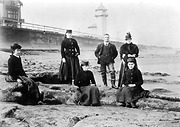 Created by James Whitehead Pattison
Donated by Bowes Museum, Barnard Castle, County Durham
Created by James Whitehead Pattison
Donated by Bowes Museum, Barnard Castle, County DurhamPart of the Pattison's Photographs collection
Dated 1888
Willy Staveley strikes a pose with his sister and a group of young ladies on the beach with the Seaton low light as a backdrop in 1888.
More detail » Group on the rocks
Group on the rocks
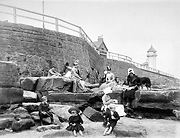 Created by James Whitehead Pattison
Donated by Bowes Museum, Barnard Castle, County Durham
Created by James Whitehead Pattison
Donated by Bowes Museum, Barnard Castle, County DurhamPart of the Part of the Pattison's Photograph Collection collection
Dated 1888
A group with a dog sitting on the rocks enjoying the fresh air. The Seaton low light and part of the Staincliffe Villas provides a backdrop.
More detail » In front of the Low Light
In front of the Low Light
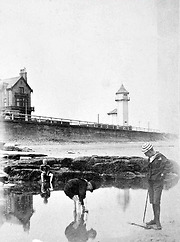 Created by James Whitehead Pattison
Donated by Bowes Museum, Barnard Castle, County Durham
Created by James Whitehead Pattison
Donated by Bowes Museum, Barnard Castle, County DurhamPart of the Pattison's Photographs collection
Dated 1888
Cooper and his two friends play in a pool on the beach. Staincliffe Villa and the lowlight stand above them.
More detail » Seaton High Light
Seaton High Light
The Seaton Lowlight and Highlight Lighthouses were built in 1838 and opened in 1839. The latter was built by James Johnston, engineer to the Tees Navigation Company.
The Lowlight stood at the end of Queen Street near the Staincliffe. It displayed a red light. It was demolished between 1900 and 1902 during a road widening scheme to allow the coastal tramway to pass.
The Highlight displayed a fixed white light. It was originally situated 1,189 yards (1,087 m) inland at the end of Windermere Road in what is now the Longhill Industrial Estate. It was a 70 feet (21m) tall Tuscan column of sandstone with the base at a height of 89 feet (27 m) above mean high tide. It contained a newel helical stair lit by slit windows between the masonry blocks. Locals called it the Longhills Lighthouse.
With the Lowlight gone it stood unused and was eventually surrounded by the Bachelor Robertson tin works which opened in 1916. It was made a listed Grade II building in 1985 due to its architectural significance. It was gifted to Hartlepool Borough Council (who hold it in the public trust) in 1995 and moved by the Teesside Development Corporation to its current site on Jacksons Landing.
Lowlights and Highlights were very important safety innovations in the 18th and 19th Century. The 1852 edition of The British and Foreign Coaster's Guide, by James Imray, stated:
"Two towers have been erected a short distance northward of Seaton Snook, on the shore behind the Long Scar Rocks, which exhibit fixed lights at 89 and 34 feet, above the sea. The buildings bear from each other, NW¾W and SE¾E, distant 1183 yards. The high light is of a bright, the low light of a red colour.
In approaching the River Tees from the southward, the best mark is Seaton lights in a line, bearing NW¾W, which may be used either in the day or night time, and which afford the safest offing off the Salt Scars, as it will carry you in about 11 to 14 fathoms to the northward of them."
 Seaton Low Light (1)
Seaton Low Light (1)
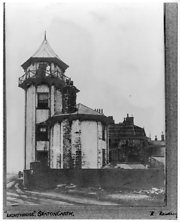 Donated by Hartlepool Museum Service
Donated by Hartlepool Museum ServiceThe Lighthouse was built in 1838/39 on the Cliff above Longscar Rocks. Another lighthouse was erected at the same time at Longhill. Seaton light was known as the lowlight and the Longhill light was known as the highlight. From out at sea one light would shine above the other, warning the mariners of the dangers of the rocks.
More detail » Seaton Low Light (2)
Seaton Low Light (2)
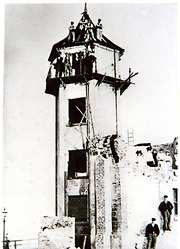 Donated by Douglas Ferriday
Donated by Douglas FerridayPart of the Hartlepool Library Service collection
This image shows the demolition of the lighthouse in 1900. There are certainly no health and safety regulations in place here. Note that there are even five females posing behind the demolished brickwork.
HHT&N 598
More detail » Seaton old light
Seaton old light
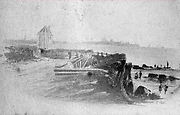 Created by Thomas Thorpe
Donated by Bowes Museum, Barnard Castle, County Durham
Created by Thomas Thorpe
Donated by Bowes Museum, Barnard Castle, County DurhamPart of the Part of the Pattison's Photograph Collection collection
Dated 1848
A sketch entitled 'Seaton old light and sand pit' by Thomas Thorpe was in Margaret Lawson's book that was in Pattison's collection.
More detail » Staincliffe House 2
Staincliffe House 2
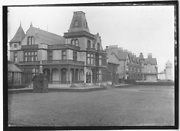 Part of the Hartlepool Museum Service collection
Part of the Hartlepool Museum Service collectionTaken when still a private residence, Staincliffe Villas and the lighthouse can be seen to the right.
More detail » Staincliffe Villas
Staincliffe Villas
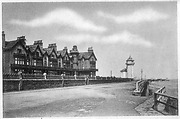 Created by Unknown
Donated by Maureen Anderson
Created by Unknown
Donated by Maureen AndersonThe villas were built about 1869 by Thomas Walker next to his house. The lowlight stands on the sea side of the track.
More detail » Staincliffe villas (2)
Staincliffe villas (2)
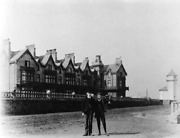 Created by James Whitehead Pattison
Donated by Bowes Museum, Barnard Castle, County Durham
Created by James Whitehead Pattison
Donated by Bowes Museum, Barnard Castle, County DurhamPart of the Pattison's Photographs collection
Dated 1888
J Hogg and S Simpson posing in front of the villas. These buildings became big news when John Darwin faked his own death in 2002 and then reappeared alive and well in 2007. He and his wife had lived in one of these buildings and owned one next door in which Darwin hid after his 'death' until he could make his getaway.
More detail » The Cliff and Staincliffe - c1880
The Cliff and Staincliffe - c1880
 Donated by Maureen Anderson
Donated by Maureen AndersonProbably about 1880 this image shows the old sea wall and the relatively narrow roadway that was in place at the time. The houses were built for wealthy merchants who did not want to live in the hustle and bustle of Hartlepool and West Hartlepool. The Seaton low light can be seen at the back of the view.
More detail »



